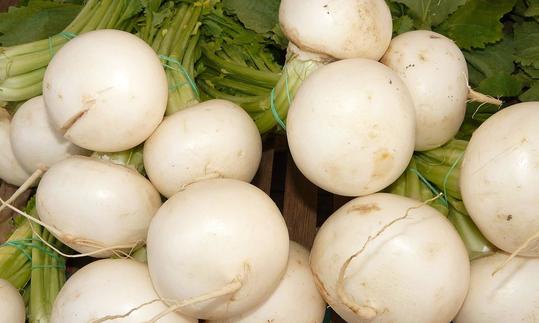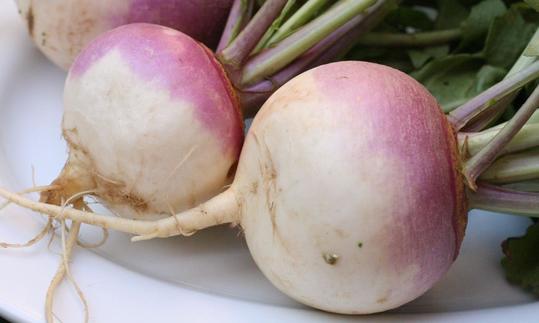Table of contents
The turnip ( Brassica rapa subsp. rapa) is used both raw and cooked. It is available in grocery stores mainly in early summer and late autumn - also in organic quality.
Using turnips in the kitchen:
The turnip species ( Brassica rapa subsp. rapa) includes several varieties that differ in shape, color and taste. Well-known ones include turnips ( Brassica rapa subsp. rapa var. majalis), autumn turnips ( Brassica rapa subsp. rapa subvar. esculenta) and Teltower turnips ( Brassica rapa subsp. rapa f. teltowiensis). The small turnips are usually spherical, have a white, reddish or yellowish skin and taste mild and slightly sweet. Autumn turnips are somewhat larger, usually white-violet in color and have a more bitter taste than turnips. Teltower turnips are more conical and have a white to brownish color. In general, it can be said that turnips taste subtly like radishes or a mixture of radishes and kohlrabi. In addition to the beets, the leaf stalks and leaves are also edible. They can be prepared as vegetables in a similar way to spinach or Chinese cabbage, or eaten raw and finely chopped as a raw vegetable salad.
The turnips can be eaten raw, cooked or pickled - peeled and usually cut into slices or strips. Cooked turnips make a wonderful vegetable side dish, in soups, stews and curries. They are also highly recommended as a puree, on their own or with celeriac, or made into a casserole with sauerkraut and potatoes. Turnips can also be fried like chips or briefly fried in a frying pan like fried potatoes. Another recommendation is to glaze the turnips with maple syrup and parsley. Raw turnips taste excellent in salads - they go well with rocket, radicchio, apples, plums and walnuts - or as a vegetable dip for starters or aperitifs.
Recipe for vegan turnip carpaccio:
Ingredients (for 4 people): 2 turnips (raw, organic), 2 beetroot bulbs, ½-1 white radish, 1 lamb's lettuce (alternatively a handful of rocket), 2 tablespoons sesame seeds, 2 tablespoons rapeseed oil, 2 tablespoons white balsamic vinegar, a little salt andpepper.
Preparation: Peel the turnips, beetroot and radish and cut into wafer-thin slices or slice them. Wash the purslane or rocket and shake dry. Crush the sesame seeds in a mortar. Arrange the vegetable slices in a fan shape on plates, season with salt and pepper and drizzle with oil and balsamic vinegar. Spread the purslane in the middle of the vegan turnip carpaccio, drizzle a little balsamic vinegar on top and sprinkle everything with sesame seeds.
Vegan recipes with turnips can be found under the note: " Recipes that have the most of this ingredient ".
| Not only vegans or vegetarians should read this: Vegans often eat unhealthily. Avoidable nutritional errors. |
Shopping - where to buy turnips?
Turnips are available seasonally in some supermarkets (e.g. Coop, Migros, Rewe, Edeka). Other supermarkets (e.g. Denner, Volg, Spar, Aldi, Lidl, Hofer) rarely or never offer the turnips. Even in organic supermarkets (e.g. Alnatura, Denn's Biomarkt) turnips are only occasionally found. If you're lucky, you'll find them at a local weekly market.
When buying, look for young specimens that are firm and crisp. A rubbery consistency indicates long and poor storage.
Found in the wild:
Based on gene sequence data, Brassica rapa is thought to have a wild relative that occurs naturally in the Caucasus, Siberia and Italy. 1
Storage:
Unwashed and without green leaves, turnips will stay fresh for two to three weeks in the vegetable compartment of the refrigerator. For longer storage, the turnips can be stored without leaves in a box with damp sand in a cool cellar compartment. This will keep the turnips for around 5-6 months. The turnips can also be frozen. To do this, peel the turnips, cut them into slices, blanch them briefly and then rinse them in cold water.
Turnip: Ingredients - Nutritional values - Calories:
The energy content of turnip (raw) is only 28 kcal per 100 g. It does not contain much protein at 0.9 g/100 g and fat at 0.1 g/100 g. Carbohydrates are present at 6.4 g per 100 g. Turnips consist of approximately 92% water. 2
21 mg of vitamin C (ascorbic acid) are found in 100 g of raw turnips - that makes up 26% of the daily requirement. Swede (25 mg/100g) and horseradish (25 mg/100g) have comparable contents. Yellow bell peppers contain significantly more vitamin C at 184 mg/100g. 2
The potassium content is 191 mg per 100 g (10% of the daily requirement). A similar amount is found in asparagus (202 mg/100g) and turnips (200 mg/100g). Pulses have particularly high levels of potassium, such as white beans (1,795 mg/100g) and soybeans (1,797 mg/100g) - however, the content is reduced by the cooking process. 2
Raw turnips also contain 15 µg of folate (folic acid) per 100 g (8% of the daily requirement). This content is comparable to that of kohlrabi (16 µg/100g) and tamarind (sweet) (14 µg/100g). Here too, some pulses exceed the folate content of turnips, such as raw chickpeas with 557 µg/100g and edamame (303 µg/100g). 2
The complete ingredients of turnip (raw), the coverage of the daily requirement and comparison values with other ingredients can be found in our nutrient tables. In the article Nutrients explained you will get a detailed insight into the topic.
Health aspects - effects:
Due to their low calorie content, beets are well suited to a weight-loss diet. In addition, even after cooking, beets are rich in the secondary plant substances glucosinolates, which have well-documented health benefits when consumed regularly. Bitter beets have a higher content of glucosinolates than sweet-tasting ones. 3
According to a 2007 study, although turnip is an easily accessible food source of biologically active compounds, the root does not seem to be the most interesting edible part, as it has only a low amount of phenolic compounds and a low antioxidant capacity. The flower buds showed the strongest antioxidant capacity. 4
Dangers - Intolerances - Side effects:
There are no known serious side effects from eating turnips. However, people with sensitive stomachs may experience abdominal pain and flatulence if they consume too much.
Folk medicine - naturopathy:
In folk medicine, turnip juices are considered to be cough-relieving. The mustard oil derivatives they contain, which have antibacterial, antiviral and antifungal effects, are responsible for this effect. 5
Occurrence - Origin - Ecology:
The turnip is one of the oldest cultivated vegetables, having been grown in Europe since 2,500-2,000 BC and then spread to other parts of the world. 9 This species is particularly popular in the colder regions of Europe. 4
Growing in the garden or as a pot plant:
Turnips are relatively undemanding. Loamy and sandy humus-rich soils are well suited. The pH value of the soil should be more than 6.5. You can mix some compost into the soil before sowing, but you should avoid excessive nitrogen release. 6
From mid-March to early August, turnips can be sown directly in the field. The row spacing of the varieties varies. May turnips require a row spacing of 20 cm, autumn turnips 25-50 cm and Teltower turnips 12-15 cm. The distance between plants within the row also varies. May turnips are spaced out to about 10-15 cm, autumn turnips to 20-30 cm and Teltower turnips to 8-12 cm. If there is no rain for a long time, you should water them, as dryness increases the risk of bolting. 6
The sown turnips can be harvested from the beginning of June to mid-November. The Teltower turnips are best harvested when they have a diameter of about 5 cm. May turnips should be harvested before they have reached a diameter of 6-8 cm. 6
Environmental aspects:
Unlike potatoes, beets are not grown commercially and in large quantities in the United States, for example, so their environmental impact is less. However, the water consumption during cultivation is relatively high and thus has a greater negative impact in countries with fewer water resources. 7
Organically grown turnips should be preferred as they have been grown without the use of chemical pesticides and fertilizers.
Danger of confusion:
Turnips and swedes belong to the same genus ( Brassica), but are two different species. They look similar, but some differences are noticeable. Turnips have thin, hairy, light green leaves, while swedes have thick, smooth, bluish leaves. The flesh of the turnip is whitish, while that of the swede is yellowish. Swedes are also usually larger, as turnips are usually harvested a little earlier. The taste of the swede is milder, but also sweeter than the turnip.
General information:
The turnip ( Brassica rapa subsp. rapa) belongs to the cruciferous family (Brassicaceae). Teltower turnips, May turnips, autumn turnips, Gatower balls and Bavarian turnips are varieties of the turnip. The mild and slightly sweet Teltower turnips are the finest tasting representatives. They were originally only grown in Teltow near Berlin, but there are now other growing areas. 8
Alternative names:
The turnip is also known as water turnip, straw turnip, stubble turnip and white turnip. Although autumn turnip, May turnip and Teltower turnip are varieties of the turnip, the names are often considered synonyms.
In English, the turnip is usually called turnip.
Keywords for use:
Originally, the Irish carved their Jack-O'Lanterns on Halloween out of turnips, not pumpkins. The Irish who immigrated to America changed the tradition in favor of pumpkins, as they were more readily available there. 7
Literature - Sources:
Bibliography - 9 Sources (Link to the evidence)
| 1. | Pflanzenforschung.de Rübsen-Archäologie. Auf der Suche nach dem verlorenen Genpool. |
| 2. | USDA United States Department of Agriculture. |
| 3. | Nor NDM, Lignou S, Bell L, Houston-Price C, Harvey K, Methven L. The relationship between glucosinolates and the sensory characteristics of steamed-pureed turnip (Brassica rapa subsp. Rapa l.). Foods. 2020;9(11):1719. |
| 4. | Fernandes F. Valentao P. Sousa C. Pereira JA. Seabra RM. Andrade PB. Chemical and antioxidative assessment of dietary turnip (Brassica rapa var. rapa L.). Food Chemistry. 2007;105(3):1003–10. |
| 5. | Geo.de Alpenmedizin: Tipps aus der Naturapotheke. |
| 6. | Gartenratgeber.net Speiserüben. |
| 7. | Foodprint.org Turnips. |
| 8. | Gemuesekorb.info Speiserüben. |
| 9. | Zhang N, Zhao J, Lens F, Visser J de, Menamo T, Fang W, u. a. Morphology, carbohydrate composition and vernalization response in a genetically diverse collection of asian and european turnips (Brassica rapa subsp. rapa). PLOS ONE. 2014;9(12):e114241. |










Comments